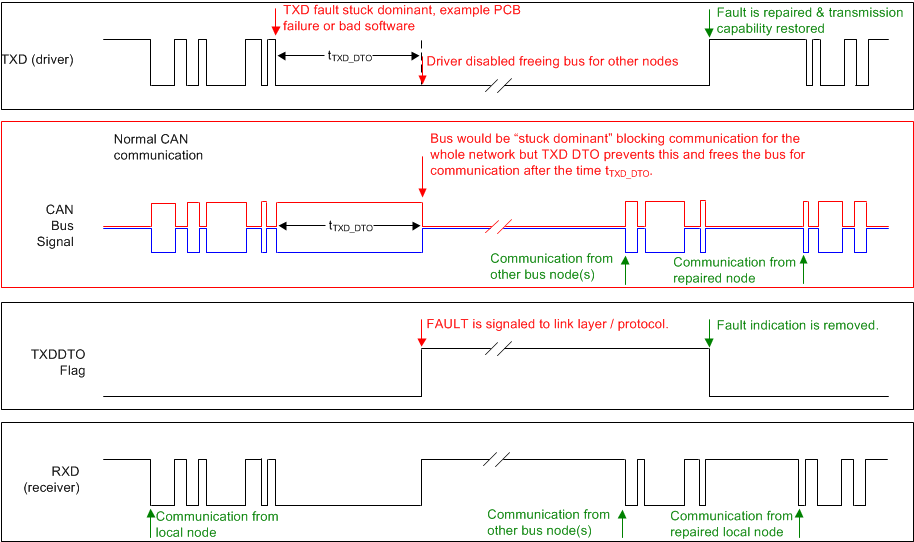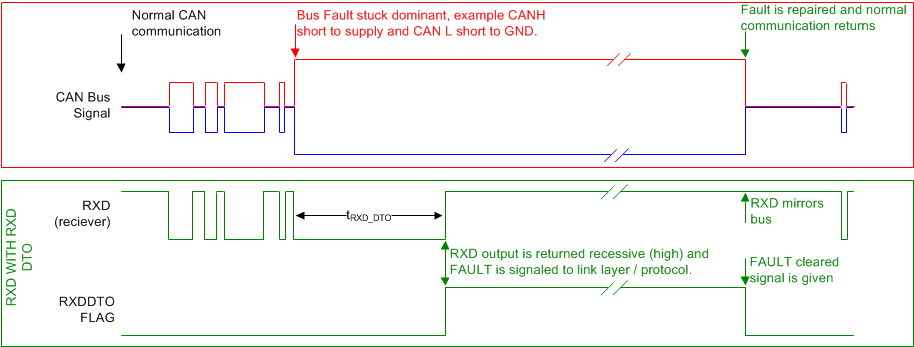SLLSEQ7E December 2015 – December 2019 TCAN330 , TCAN330G , TCAN332 , TCAN332G , TCAN334 , TCAN334G , TCAN337 , TCAN337G
PRODUCTION DATA.
- 1 Features
- 2 Applications
- 3 Description
- 4 Revision History
- 5 Description (continued)
- 6 Device Options
- 7 Pin Configuration and Functions
- 8 Specifications
- 9 Parameter Measurement Information
- 10Detailed Description
- 11Application and Implementation
- 12Power Supply Recommendations
- 13Layout
- 14Device and Documentation Support
- 15Mechanical, Packaging, and Orderable Information
Package Options
Mechanical Data (Package|Pins)
Thermal pad, mechanical data (Package|Pins)
- DCN|8
Orderable Information
8.6 Switching Characteristics
over operating free-air temperature range (unless otherwise noted)| PARAMETER | TEST CONDITIONS | MIN | TYP | MAX | UNIT | |
|---|---|---|---|---|---|---|
| Device Switching Characteristics | ||||||
| tPROP(LOOP) | Total loop delay, driver input (TXD) to receiver output (RXD), recessive to dominant and dominant to recessive | See Figure 23, S, STB and SHDN = 0 V, RL = 60 Ω, CL = 100 pF, CL(RXD) = 15 pF | 100 | 135 | ns | |
| tPROP(LOOP) | Total Loop delay in highly loaded network | See Figure 23, S, STB and SHDN = 0 V, RL = 120 Ω, CL = 200 pF,
CL(RXD) = 15 pF |
120 | 180 | ns | |
| tBUS_SYM_2 | 2 Mbps transmitted recessive bit width | See Figure 24, S or STB = 0 V, RL = 60 Ω, CL = 100 pF, CL(RXD) = 15 pF,
tBIT = 500 ns TCAN330G, TCAN332G, TCAN334G and TCAN337G only |
435 | 530 | ns | |
| tREC_SYM_2 | 2 Mbps received recessive bit width | 400 | 550 | ns | ||
| ΔtSYM_2 | 2 Mbps receiver timing symmetry
(tREC_SYM_2 - tBUS_SYM_2) |
–65 | 40 | ns | ||
| tBUS_SYM_5 | 5 Mbps transmitted recessive bit width | See Figure 24, S or STB = 0 V, RL = 60 Ω, CL = 100 pF, CL(RXD) = 15 pF,
tBIT = 200 ns TCAN330G, TCAN332G, TCAN334G and TCAN337G only |
155 | 210 | ns | |
| tREC_SYM_5 | 5 Mbps received recessive bit width | 120 | 220 | ns | ||
| ΔtSYM_5 | 5 Mbps receiver timing symmetry
(tREC_SYM_5 - tBUS_SYM_5) |
–45 | 15 | ns | ||
| tMODE | Mode change time | See Figure 21 and Figure 22.
RL = 60 Ω, CL = 100 pF, CL(RXD) = 15 pF |
5 | 10 | µs | |
| tUV_RE-ENABLE | Re-enable time after UV event | Time for device to return to normal operation from UV(VCC) under voltage event | 1000 | µs | ||
| tWK_FILTER | Bus time to meet Filtered Bus Requirements for Wake Up Request | See Figure 33, Standby mode.
–12 V < VCM < 12 V |
0.5 | 4 | µs | |
| Driver Switching Characteristics | ||||||
| tpHR | Propagation delay time, HIGH TXD to Driver Recessive | See Figure 19, S, STB and SHDN = 0 V. RL = 60 Ω, CL = 100 pF, | 25 | ns | ||
| tpLD | Propagation delay time, LOW TXD to Driver Dominant | 20 | ||||
| tsk(p) | Pulse skew (|tpHR - tpLD|) | 5 | ||||
| tr | Differential output signal rise time | 17 | ||||
| tf | Differential output signal fall time | 9 | ||||
| tTXD_DTO | Driver dominant time out (1) | See Figure 25,
RL = 60 Ω, CL = 100 pF |
1.2 | 2.6 | 3.8 | ms |
| Receiver Switching Characteristics | ||||||
| tpRH | Propagation delay time, bus recessive input to high RXD output | See Figure 20, CL(RXD) = 15 pF CANL = 1.5 V, CANH = 3.5 V | 62 | ns | ||
| tpDL | Propagation delay time, bus dominant input to RXD low output | 56 | ||||
| tr | Output signal rise time (RXD) | 7 | ||||
| tf | Output signal fall time (RXD) | 6 | ||||
| tRXD_DTO | Receiver dominant time out (2) | See Figure 27, CL(RXD) = 15 pF | 1.6 | 3 | 5 | ms |
(1) The TXD dominant time out (tTXD_DTO) disables the driver of the transceiver once the TXD has been dominant longer than tTXD_DTO, which releases the bus lines to recessive, preventing a local failure from locking the bus dominant. The driver may only transmit dominant again after TXD has been returned HIGH (recessive). While this protects the bus from local faults, locking the bus dominant, it limits the minimum data rate possible. The CAN protocol allows a maximum of eleven successive dominant bits (on TXD) for the worst case, where five successive dominant bits are followed immediately by an error frame. This, along with the tTXD_DTO minimum, limits the minimum bit rate. The minimum bit rate may be calculated by: Minimum Bit Rate = 11/ tTXD_DTO = 11 bits / 1.2 ms = 9.2 kbps.
(2) The RXD timeout (tRXD_DTO) disables the RXD output in the case that the bus has been dominant longer than tRXD_DTO, which releases RXD pin to the recessive state (high), thus preventing a dominant bus failure from permanently keeping the RXD pin low. The RXD pin will automatically resume normal operation once the bus has been returned to a recessive state. While this protects the protocol controller from a permanent dominant state, it limits the minimum data rate possible. The CAN protocol allows a maximum of eleven successive dominant bits (on RXD) for the worst case, where five successive dominant bits are followed immediately by an error frame. This, along with the tRXD_DTO minimum, limits the minimum bit rate. The minimum bit rate may be calculated by: Minimum Bit Rate = 11 / tRXD_DTO = 11 bits / 1.6 ms = 6.9 kbps.
 Figure 1. Example Timing Diagram for TXD DTO and FAULT Pin
Figure 1. Example Timing Diagram for TXD DTO and FAULT Pin  Figure 2. Example Timing Diagram for RXD DTO and FAULT Pin
Figure 2. Example Timing Diagram for RXD DTO and FAULT Pin